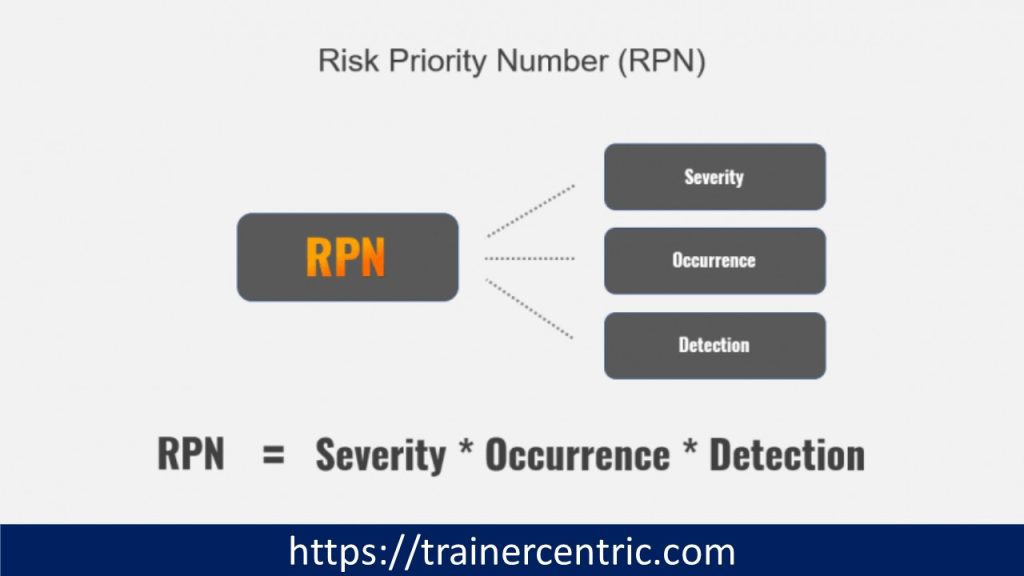Introduction
RPN is a mathematical worth that is determined in light of three factors: the seriousness of the expected result, the probability of the event, and the capacity to identify the gamble.

These variables are evaluated on a size of 1 to 10, with 10 being the most significant level of seriousness, probability, or trouble of identification. In this article, we will investigate the idea of RPN in more detail, including its computation, understanding, and application in risk the executives.
Calculation of RPN
As mentioned, Risk Priority Number is calculated based on three factors: severity, likelihood, and detectability. Each of these factors is rated on a scale of 1 to 10, with 10 being the most severe, likely, or difficult to detect. The RPN value is then obtained by multiplying these three ratings together.
For example, if the severity of a potential risk is rated as 8, the likelihood as 5, and the detectability as 9, then the Risk Priority Number would be calculated as follows:
RPN = severity × likelihood × detectability = 8 × 5 × 9 = 360
The resulting RPN value ranges from 1 to 1000, with higher values indicating greater risk. However, some organizations may use a different scale, such as 1 to 10,000, or may use a weighting system to give more importance to certain factors.

Interpretation of RPN
Once the Risk priority number value is calculated, it can be used to prioritize risks for action. Generally, risks with higher RPN values are considered more critical and require more attention than those with lower values.
However, the interpretation of Risk Priority Number values should be done with caution. RPN is a tool for prioritization, not an absolute measure of risk. Therefore, organizations should consider other factors when deciding how to manage a risk, such as the potential impact on the organization, the availability of resources, and the cost of mitigation.
For example, a risk with a high Risk Priority Number value may not be as critical if the potential impact is low or if the cost of mitigation is too high. On the other hand, a risk with a lower RPN value may be more critical if it is easy to mitigate and has a high potential impact.
Furthermore, RPN values are based on subjective assessments of severity, likelihood, and detectability, which can vary depending on the individual or team assessing the risk. Therefore, organizations should aim to standardize their approach to RPN and train their staff to ensure consistency in their assessments.
Application of RPN in Risk Management
Risk Priority Number can be used in various stages of risk management, from risk identification to risk mitigation and monitoring such as Failure Mode Effects Analysis. Below are some examples of how RPN can be applied in risk management:
- Risk Identification
- RPN can be used to identify potential risks in a process, system, or product. By assessing the severity, likelihood, and detectability of different risks, organizations can prioritize their efforts to manage the most critical risks first.
- Risk Assessment
- RPN can also be used to assess the level of risk associated with a particular hazard or activity. By assigning RPN values to different hazards or activities, organizations can identify those that require more attention or resources for mitigation.
- Risk Mitigation
- RPN can be used to prioritize different mitigation strategies for a particular risk. For example, a risk
- with a high RPN value may require a more comprehensive mitigation strategy than a risk with a lower RPN value. By allocating resources based on RPN values, organizations can ensure that they are addressing the most critical risks first.
- Risk Monitoring
- RPN can also be used to monitor the effectiveness of risk mitigation strategies. By periodically re-assessing RPN values, organizations can determine whether their mitigation strategies are working or if additional actions are needed.
Limitations of RPN
While Risk Priority Number can be a useful tool for risk management, it has some limitations that should be considered.
Firstly, as mentioned earlier, RPN values are subjective and can vary depending on the individual or team assessing the risk. This can lead to inconsistent results if different people use different criteria to rate the severity, likelihood, and detectability of a risk.
Secondly, Risk Priority Number does not take into account the interdependence of risks. A high RPN value for one risk may be mitigated by the presence of a lower RPN value for another risk. Therefore, it is important to consider the overall risk profile of an organization and not just individual RPN values.
Finally, Risk Priority Number does not provide guidance on the optimal level of risk management. It only provides a relative ranking of risks but does not provide information on the number of resources or effort that should be allocated to each risk.
RPN and Root Cause Analysis
RPN can also be used in conjunction with root cause analysis (RCA) to identify the underlying causes of a risk and develop targeted mitigation strategies. By analyzing the factors that contribute to a high RPN value, organizations can identify the root cause of the risk and develop targeted actions to address it.
For example, if a high RPN value is due to a lack of training or awareness among employees, the organization can develop targeted training programs or awareness campaigns to address this issue. By addressing the root cause of the risk, organizations can prevent similar risks from occurring in the future.
RPN and Continuous Improvement
Risk Priority Number can also be used as a tool for continuous improvement. By periodically assessing and re-assessing RPN values, organizations can identify areas where they have made progress and areas where additional effort is needed.
For example, if a risk has a high RPN value in one assessment, but a lower RPN value in a subsequent assessment, the organization can determine whether its mitigation efforts were effective or if additional actions are needed.
RPN and Communication
Risk Priority Number can also be a useful tool for communicating risks and risk management strategies to stakeholders. By presenting RPN values in a clear and concise manner, organizations can help stakeholders understand the relative importance of different risks and the strategies that are being used to manage them.
However, it is important to ensure that stakeholders understand the limitations of RPN and that other factors, such as the overall risk profile of the organization, are also considered when making risk management decisions.
Conclusion
In conclusion, Risk Priority Number (RPN) is a useful tool for identifying, assessing, and prioritizing risks in an organization. By considering the severity, likelihood, and detectability of a risk, organizations can use RPN to focus their risk management efforts on the most critical risks.
However, Risk Priority Number should be used with caution and should be considered as a tool for prioritization, not an absolute measure of risk. Organizations should also consider other factors when deciding how to manage a risk, such as the potential impact on the organization, the availability of resources, and the cost of mitigation.
By using RPN in conjunction with other risk management tools and techniques, organizations can ensure that they are effectively managing their risks and minimizing negative outcomes.

![The Power of Storytelling in Corporate Training: Igniting Success and Inspiring Growth [2023]](https://trainercentric.com/wp-content/uploads/2023/06/storytelling-1024x576.jpg)

